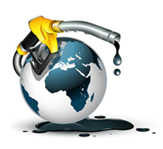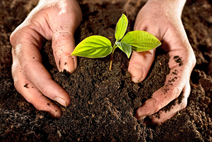A vegan diet is not only the healthiest diet but also the "greenest" (and of course the most humane).
Here are its many "side-effects":
Immense reduction in our carbon footprint & reducing our reliance on fossil fuels - The meat industry uses more than one-third of all fossil fuels consumed in the U.S, and it is responsible for more greenhouse-gas emissions than all the cars, trucks, planes, and ships in the world COMBINED. It takes 10 times more fossil fuels to produce meat than vegan protein. You conserve more energy going vegan than driving a hybrid car all year. [New UN Report Says Vegan Diet Vital To Saving The Environment, Curbing Fossil Fuel Use]

Alleviating world hunger & conserving the planet’s food-producing soil - "The 4.8 pounds of grain fed to cattle to produce one pound of beef for human beings represents a colossal waste of resources in a world still teeming with people who suffer from profound hunger and malnutrition. According to the British group Vegfam, a 10-acre farm can support 60 people growing soybeans, 24 people growing wheat, 10 people growing corn and only two producing cattle. Britain—with 56 million people—could support a population of 250 million on an all-vegetable diet. Because 90 percent of U.S. and European meat eaters’ grain consumption is indirect (first being fed to animals), westerners each consume 2,000 pounds of grain a year. Most grain in underdeveloped countries is consumed directly. While it is true that many animals graze on land that would be unsuitable for cultivation, the demand for meat has taken millions of productive acres away from farm inventories. The cost of that is incalculable. As Diet For a Small Planet author Frances Moore Lappé writes, imagine sitting down to an eight-ounce steak. "Then imagine the room filled with 45 to 50 people with empty bowls in front of them. For the ‘feed cost’ of your steak, each of their bowls could be filled with a full cup of cooked cereal grains.” Harvard nutritionist Jean Mayer estimates that reducing meat production by just 10 percent in the U.S. would free enough grain to feed 60 million people." [EMagazine.com, "The Case Against Meat"] More than 260 million acres of US forest have been cleared for grazing and for growing grain to feed farmed animals.
"A global shift towards a vegan diet is vital to save the world from hunger, fuel poverty and the worst impacts of climate change, a UN report said today. As the global population surges towards a predicted 9.1 billion people by 2050, western tastes for diets rich in meat and dairy products are unsustainable, says the report from United Nations Environment Programme's (UNEP) international panel of sustainable resource management." [UN urges global move to meat and dairy-free diet]
Water conservation - A pound of wheat can be grown with 60 pounds of water, whereas a pound of meat requires 2,500 to 6,000 pounds. Livestock production accounts for half of all the water used in the US. A vegetarian uses only about 300 gallons of water a day, while a meat-eater uses more than 4000. [Saving the Earth One Bite at a Time]

Ending animal cruelty - The conditions on factory farms, which produce most of the meat consumed in the US, are unspeakable. It is unimaginable to grasp the amount of suffering endured by those animals in their short lives. If you don't believe, learn more at HSUS's website or meet your meat.
Environmental conservation and stewardship - The demand for meat is a demand for land when the animals are not raised in factory farms; this means clear-cutting woodlands to make room for pasture, displacing or effectively wiping out native flora and fauna. When the animals are raised in factory farms, the pollution produced is nothing short of overwhelming: "The more than 10 billion land animals raised for food each year in the United States excrete massive quantities of urine and feces. According to a Minority Staff of Senate Committee on Agriculture, Nutrition & Forestry report, the amount of farmed animal manure produced in the United States equals five tons of waste for every woman, man, and child. [..] [T]he waste generated on factory farms can be hundreds of times more concentrated than untreated domestic sewage." [Saving the Earth One Bite at a Time] "Industrial agriculture is one of the leading causes of water pollution in the United States today. In the 2000 National Water Quality Inventory conducted by the Environmental Protection Agency (EPA), agricultural activity was identified as a source of pollution for 48% of stream and river water, and for 41% of lake water. Water pollution from industrial farms not only damages the environment and kills wildlife, but it can also sicken and kill people." [Water Pollution]

Reducing national medical expenses & preventing pandemic diseases - As evidenced by the medical research and clinical studies listed in the Dietary Truth booklet, eating a whole food plant-based diet will reduce the incidence of so many cancers and other ailments, the medical cost savings could be truly mind-blowing, especially if applied on a national scale. [Study: Medical Cost of Obesity Soars] And the ever-present threat of pandemic flu or similar disease can be mostly credited to the severely overcrowded and unsanitary conditions on factory farms, where the still-circulating swine and bird flu began their infamous existence.[Bird Flu: A Virus of Our Own Hatching]
Saving countless land- and ocean-dwelling species from extinction - Habitat loss is the number one cause of species extinction - whether it is displacement by human expansion, pollution of a native environement beyond sustenance of its ecosystem, or over-harvesting of a vital resource, or all of the above. We are losing species at an alarming rate; in the Amazon Rainforest alone, 1 species goes extinct about every 15 seconds. More than 90 percent of all Amazon rainforest land cleared since 1970 is used for meat production. The oceans are so overfished, some experts fear a global fisheries collapse has already begun. [Historical Overfishing and the Recent Collapse of Coastal Ecosystems] Commercial fishing nets often scrape the ocean floor clear of all life and destroy coral reefs; they also kill porpoises, birds, sea lions, and other "bycatch" animals. Coastal fish farms release massive amounts of feces, antibiotics, parasites, and non-native fish into sensitive marine ecosystems. "According to the journal Science, a two-acre salmon farm produces as much waste as a town of 10,000 people. Aquaculture farms dump waste, pesticides, and other chemicals directly into ecologically fragile coastal waters. Local ecosystems are destroyed, devastating animals and plants." [Saving the Earth One Bite at a Time] Going vegan conserves all vital resources for life on this planet and reduces pollution on a grand scale.






